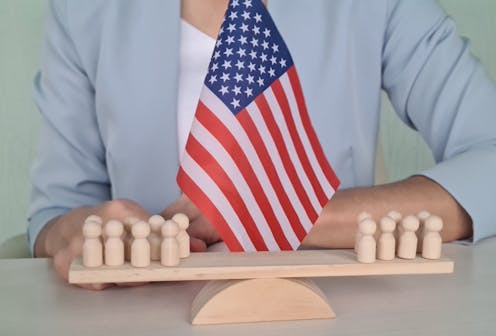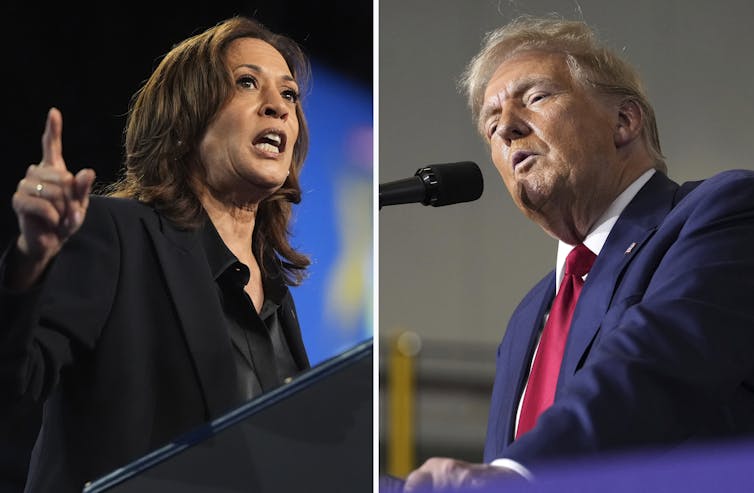
Many Americans are not thrilled with either of the two major-party candidates for president. As of Oct. 4, 2024, polls showed that 46.5% had an unfavorable opinion of Kamala Harris and 52.6% felt unfavorably toward Donald Trump.
Some of these unhappy voters are considering voting for a third-party candidate, or not voting at all. They may be thinking of those actions as a form of protest against the two-party system dominant in the United States, or against these two particular candidates.
For example, in a September poll 3.5% of Michigan voters said they planned to vote for a candidate other than Harris and Trump.
At first glance, these choices might seem perfectly reasonable: If you don’t like a candidate, don’t vote for that person. But my work as a scholar of cognitive biases – systematic errors people make in their thinking – makes me fear that this option does not best serve the interests of those voters.
Instead, protest voting is in fact likely to harm the democratic process, potentially leading to the election of the candidate the majority of voters overall, and protest voters specifically, most dislike. There are several reasons protest voters might make this mistake.
How much does one vote matter?
It’s clear that any one vote is very unlikely to swing the presidential election. And some might say that if one vote doesn’t really matter, then voters may as well vote however they want, or not bother to vote at all. Here’s why that’s flawed thinking:
Suppose there are 10,000 voters in a state who feel unhappy with both candidates. But they almost surely dislike one candidate more than they dislike the other. Perhaps they disagree with some of Harris’ views but fear Trump. Or maybe it’s the other way around. They don’t have to agree on why they’re unhappy about the candidates either – some who are unhappy with Harris but prefer her over Trump may think Harris is too far left, while others may think she’s not enough of a leftist.
Now suppose the rest of the state’s voters – those who are happy to vote for one of the two major candidates – are very narrowly split. Perhaps the gap is 5,000 votes. So, if the 10,000 unhappy voters do vote for one of the two major-party candidates, they can swing the election.
Again, these unhappy voters really do have a preference – they like one of the major candidates better than the other. So while each individual unhappy voter wants to keep their hands clean and not vote, they would each like the other 9,999 unhappy voters to step up and swing the outcome in favor of their preferred candidate.
Parents teach the Golden Rule to kids – do unto others as you would have them do unto you – and most people do actually believe in it and try to act accordingly. In this case, following the Golden Rule means that if you’re an unhappy voter and would like other unhappy voters to hold their noses and vote for the major candidate they least dislike, you should be willing to do the same thing yourself.
But not all unhappy voters think this way. Some are led astray by their intuition and choose to protest-vote even when their own values would indicate they shouldn’t.

A boycott error
One reason a person might still think a protest vote makes sense is because of the assumption that boycotting something they don’t like is an effective means of contributing to positive change.
A boycott against a person or organization you have a problem with often makes good sense. For instance, if there’s a restaurant in town with a reputation for being discriminatory, or just for being slow to get the food out, don’t go to it. Maybe it will close and make room for another business with better performance. Or maybe it will make some changes in hopes of growing its customer base.
But when you cast a vote, whether on Election Day or beforehand, boycotting the viable candidates isn’t going to help. One of them is going to win whether you like it or not. Boycotting in this context is an example of a misapplied heuristic – a rule of thumb that’s often, but not always, helpful. Boycotting here doesn’t help you achieve your goal of eliminating or improving something you don’t like.
Omission vs. commission
Another reason people might choose a protest vote is because of a phenomenon in which people prefer to make mistakes of inaction – omission – over making mistakes that involve taking action – commission. People feel less guilty when they haven’t acted directly in support of a bad outcome. But both action and inaction can be errors, and both can deliver undesired results that constitute bad outcomes.
The omission bias can help explain why some people are hesitant to get vaccinated against serious diseases: If they chose to get vaccinated and the vaccination led to a health problem, that would be a mistake of commission. Not getting vaccinated also might lead to a health problem, but that would be a mistake of omission. People tend to prefer the latter.
Similarly, voting for a candidate you’re unsatisfied with could feel like a mistake of commission. Not voting, or voting for a third party, risks a mistake of omission – an error often assumed to be less significant. But choosing the possibility of an error of omission over one of commission doesn’t ensure you aren’t making a mistake – it just changes your mistake to one that’s intuitively more appealing.

False equivalence
A final reason people might opt out of voting or choose to back a third-party candidate is that they object to the assumption that they dislike one candidate more than the other. Instead, these people claim the two main options are equally bad.
But regardless of what your actual values and policy preferences are, that’s almost certainly untrue. The two candidates hold very different views on a wide range of issues, and have different records of what they have done – and not done – when in office.
People who claim the two different candidates are basically the same are misusing another mental shortcut: the human tendency to think in categories. Grouping distinct items in the same category can simplify thinking, but it can ignore substantial differences.
Some people think about 1-in-10 chances and 1-in-a-million chances as both being in the category of “possibilities.” But they’re very different: If you’re flipping a coin repeatedly, one is about equal to your chance of getting heads three times in a row, and the other is how likely you are to get heads 20 times in a row.
Seeking your most desired outcome
During the 2000 presidential campaign, I recall a friend said he wasn’t voting for Democratic candidate Al Gore because he thought Gore and Republican nominee George W. Bush were equally bad. But after winning – partly because of third-party voters who cast ballots for independent Ralph Nader – Bush withdrew the U.S. from the Kyoto Protocol to limit global carbon emissions, invaded Iraq, and passed tax cuts favoring the wealthy.
All of those were actions Gore would almost certainly not have taken. The two candidates were very far from being the same, and even though my friend didn’t see it beforehand, he should have been able to.
The U.S. will have a new president on Jan. 20, 2025: Trump or Harris. A third-party winner is not a real option.
In some states voters can rank candidates in order of preference, more clearly expressing their choices without wasting their vote on a candidate who can’t win. People who believe it would be nice to have more choices with realistic chances of winning could work to adopt that system – known as ranked-choice voting – in their communities, or seek to adopt other methods that could eventually yield more viable options in the future. But it won’t happen in time for this election.
Whether you like it or not, you face a binary choice: Vote for one or vote for the other. And please vote.
The author disclosure on this article was updated Oct. 9, 2024.
In the 2024 election cycle, Daniel Stone has donated less than $45 to Democratic campaigns through ActBlue.
This article was originally published on The Conversation. Read the original article.







